The second phase of Water and Sanitation mapping is over and with it the pilot in Mathare, which lasted for 4 months. You can read all about the events and the processes leading up to this point on our previous blog entries. I will call this an intermediary analysis because the work is by no means over, but we’re at a good stopping point to reflect and set the way forward.

Here’s the data we collected regarding toilets, water points and open defecation areas, and what it tells us (these numbers reflect the data which we collected during our pilot):
Toilets
- We collected 144 points of interest where toilets are located in the whole of Mathare. These points have 373 individual units attached to them. These are mostly publicly accessible points, meaning we only took points which are public and, for example, didn’t walk into people’s homes.
- Most of these toilets are privately owned, with 50% of the toilets having known ownership. The other 50% are owned by different organizations, government, etc. and are considered public.
- The majority, 50%, of the toilets with known type are Asian Style, followed by 26% pit latrines, and 11% hanging toilets. The rest are trench and English toilets.
- Most of the toilets are located in the public within the communities; this is because we collected mostly public toilets in the first place. I’m happy to say that 90% of collected toilets are operational.
- Most toilets are connected to sewage (60%), and have available piped water (54%), and are usually cleaned, either by the operator (38%) or the caretaker (33%). Many toilets have almost non-existent hand washing accessories (37%) and non-existent towel bins (0,7%).
Couple of visualizations of the upper data displayed on maps:
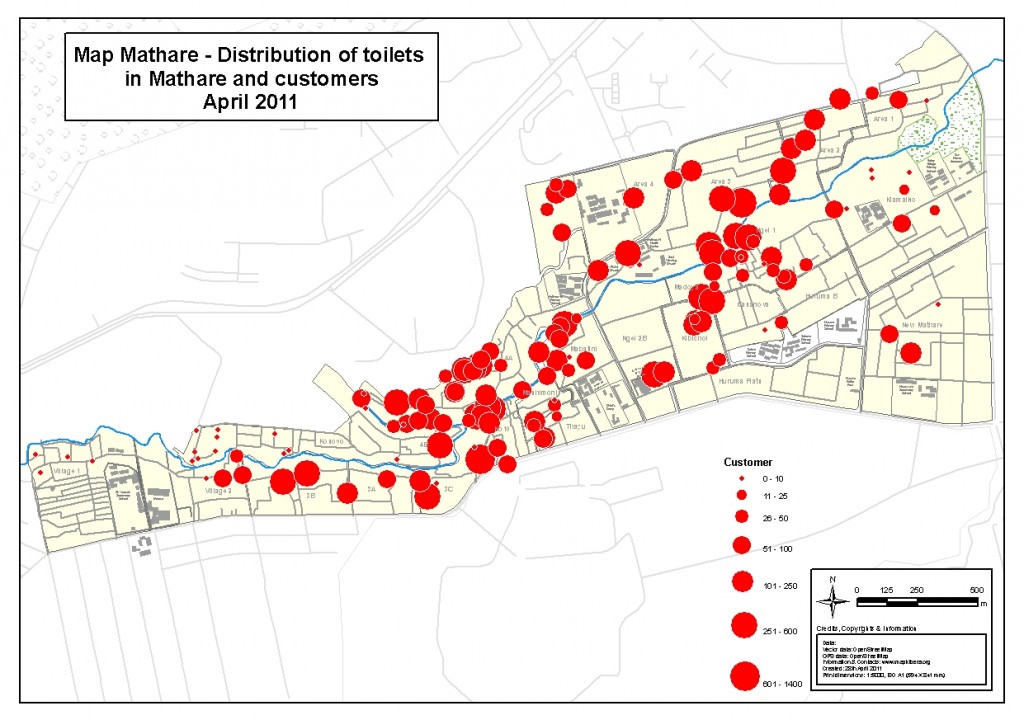
Distribution of toilets in Mathare and customers
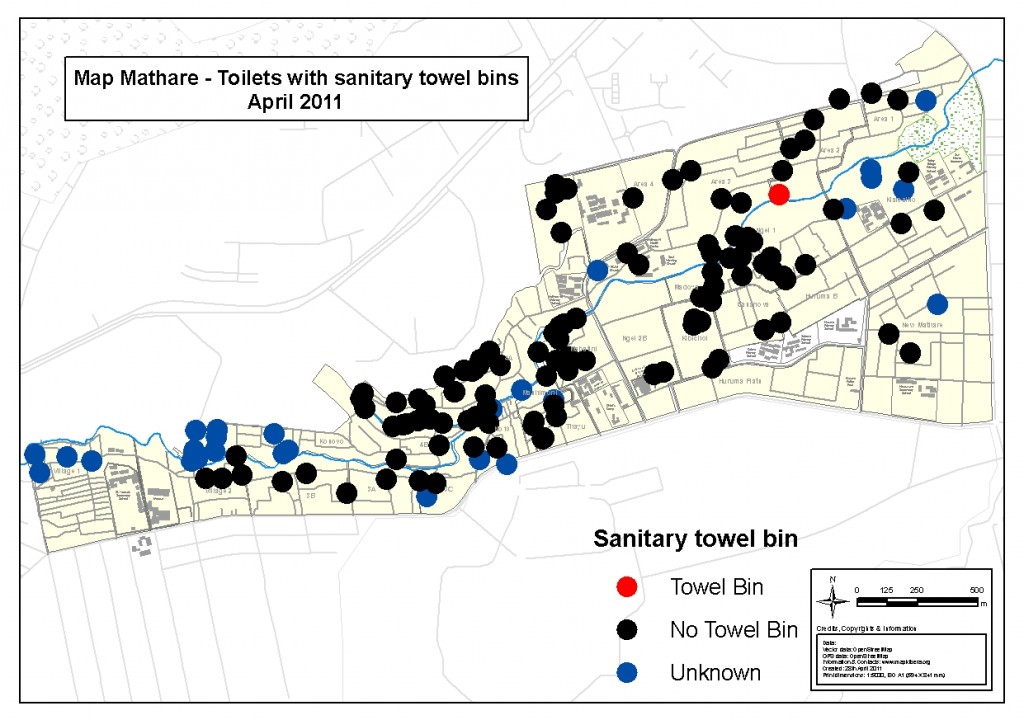
Toilets with sanitary towel bins

Toilet connection
Water points
- We collected 167 water points.
- 60% of these water points are privately owned. As with toilets, the rest are owned by different organizations, government etc. and are considered public.
- Most of these water points are piped or tap water (75%), while others are water tanks.
- As with toilets, most of the water points are located in the public within the communities.
- 98% of collected water points are operational and have connection to water pipes.
A visualization of the upper data displayed on a map:
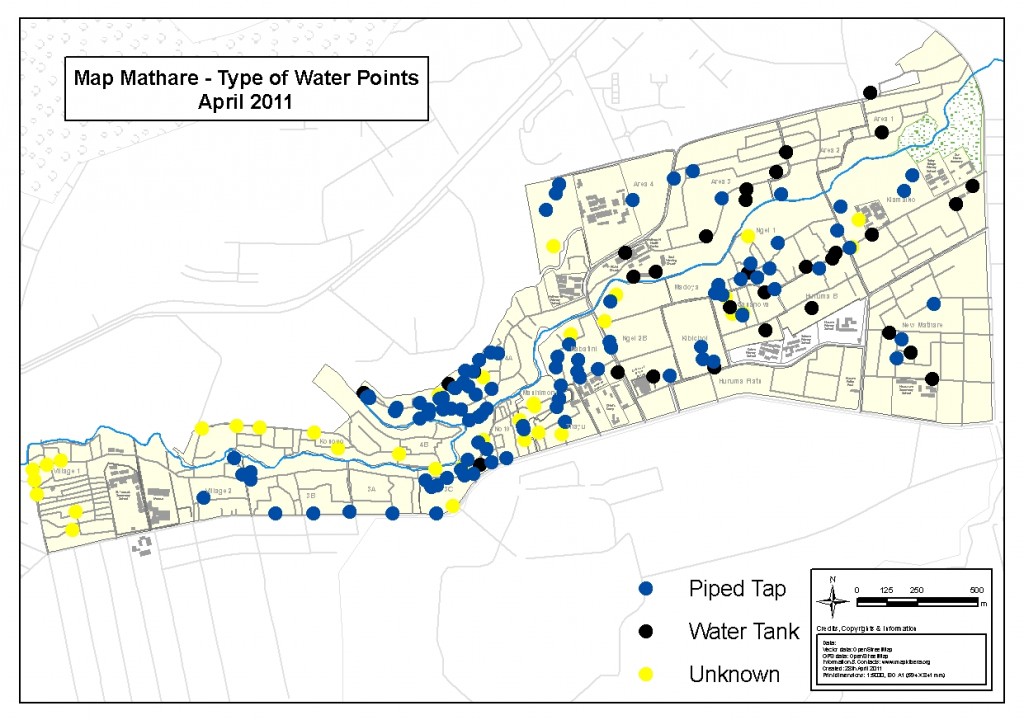
Type of water points
Open defecation areas
Open defecation areas cover 16144 m2 of Mathare (3 km2) and their placements vary throughout the slum.  They are mostly located in the areas where there are majority corrugated iron sheet houses, which usually don’t contain toilets.
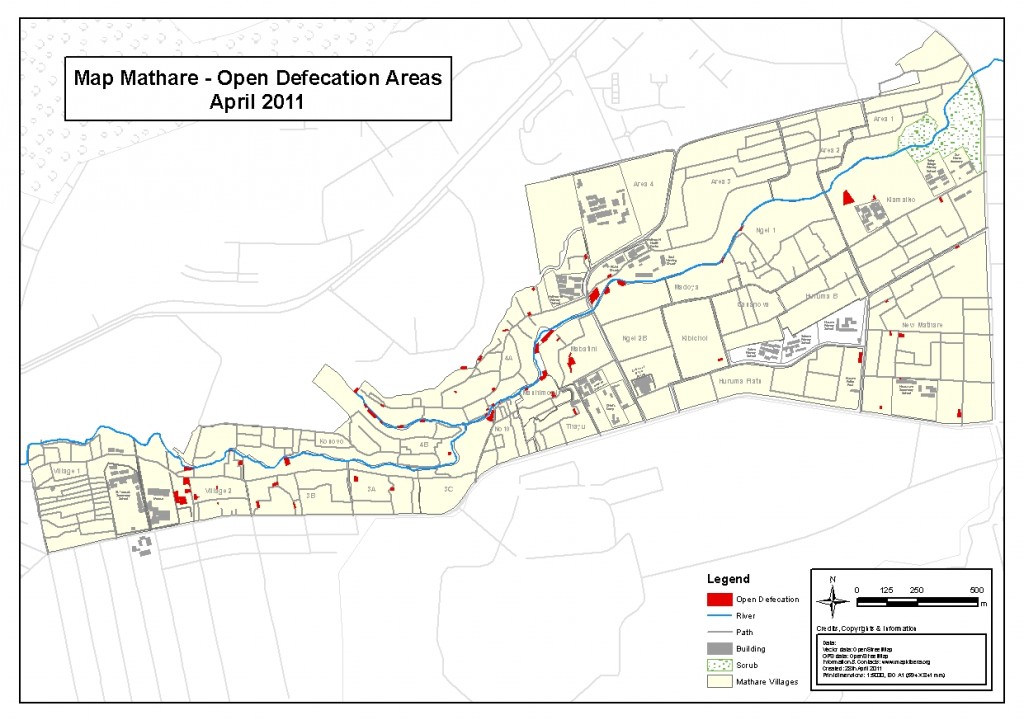
Open Defecation Areas
More of the same on Mapping: No Big Deal
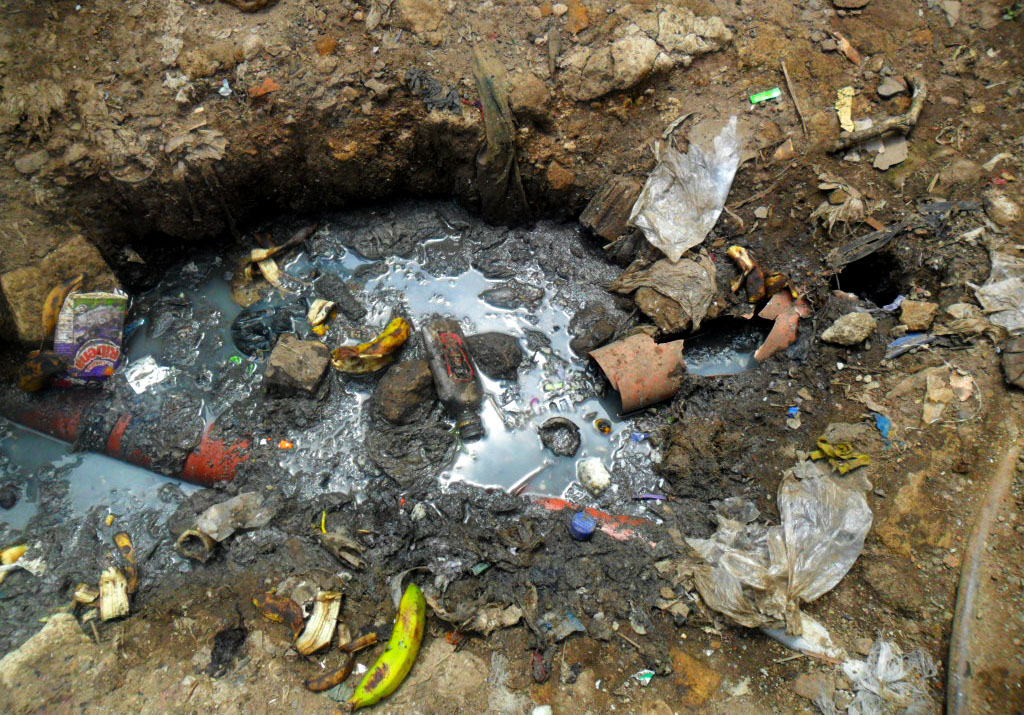
Open Drainage
I believe that the reasons to map open drainage in the slums are well known and are obvious to most people. Everyone who’s ever been to the slums knows that open drainage presents a huge health hazard to the people living around it. In combination with poor or non-existent water and sanitation systems, open drainage presents a recipe for disaster which is always present and can erupt at any time and wreak havoc amongst the populations. If I quote a few experts on the dangers that open drainage poses:
“Potholes in the streets, pools of stagnant water, and waste gushing from bathrooms and kitchens provide breeding sites for malarial mosquitoes and other spreaders of disease.†(Nwaka, Geoffrey I. “The Urban informal Sector in Nigeriaâ€)
“Most slum households must fetch their water from a standpipe and deposit their waste in open drains. The rate of infection is high; therefore there is constant risk of epidemic.†(Gulis et. Al. “Health status of people of slums in Nairobi, Kenyaâ€)
“In slum areas, a minor flood is not just inconvenient. It is life-threatening. With open drains and overflowing latrines even a small flood means that children have to wade through raw sewage.†(Willem Alexander, HRH, Chair of UNSGAB. “World Water Day Op Edâ€)
In an article on the health status of people of slums in Nairobi, Kenya the authors conclude that: “Environmental conditions can have major influences on health status. Therefore, environmental improvements are important in the improvement of health status.†(Gulis et. Al. “Health status of people of slums in Nairobi, Kenyaâ€)
As my friend Simon, a long-time resident of Mathare and our Map Mathare Coordinator, put it on the Mathare Valley blog: “One does not need to be a scientist to know what would happen in case of disease outbreak. The improvement of proper water distribution and repairing the broken water pipes coupled with constructing good drainage system is the key to fighting common illness in the slums.â€
What I can add to all of this is that in order to improve or at least start improving living conditions, you need to first know and understand the situation on the ground. By mapping open drainage areas, our mappers are providing the first detailed geographical information about how open drainage is distributed throughout Kibera and Mathare, thus providing necessary information to anyone hoping to solve the problem.
This I believe answers the question of why and brings me to the next question: How?
Obviously open drainage creates “appalling living conditions,†but maybe not so obviously, it creates appalling mapping conditions too! Open drainage winds and curves between houses, often sinks below them, intersects, flows, stands, overflows, merges with the content of broken sewage lines (sewage lines burst and sewage comes above ground, mixing with the content of open drainage), and creates pools of standing water. Open drainage is the main collector of garbage: garbage in open drainage areas often clogs drainage systems, thus creating floods during rains. All of this mesh slowly flows downwards, usually towards rivers that pick it up and carry it further downstream, polluting the environment sometimes hundreds of kilometers away.
In order to understand the scale of the problem in Mathare and Kibera we went on an investigative – or, if I put it in army terms, reconnaissance – mission with our teams to see the problem first hand. Our participants surveyed the problem, and their input helped us to better understand what we’re up against. We walked through the slum evaluating different drainage lines and problems we faced in mapping them, Sebastien (our new volunteer) and I then facilitated the mappers to decide on which points of interest we should collect and in what order.

Investigating the problem
Findings from the field regarding open drainage include:
- Open drainage has many sources and it forms for many reasons (resulting from topography and from human actions)
- It comes in many forms regarding the content and structure (garbage, water, sewage, earth trench, concrete trench, etc.)
- It has main channels with many tributaries
We came to realize that drainage systems in slums (Kibera, Mathare) basically work as micro river systems! This made us understand that it has to have an outlet, and both Kibera and Mathare have outlets in the form of rivers that run through them.
All of this helped us made our action plan:
- All the drainage flows towards the rivers, so we started collecting data along the rivers.
- The next step is to collect data for the main channels, which lie along the main paths.
- After this, we focused on the smaller paths in the slum, collecting points of interest along the way. This includes the start and end points for “following†a drainage line, intersections of different lines, man-holes (along sewage lines), and broken sewage lines. At intersections, we’re collecting the directions of different intersecting lines
- Throughout this process, the use of building extraction (when possible) helps us sketch the drainage lines
After the extensive data collection we’ll use the satellite imagery and building extraction to help us determine the exact positions of drainage lines.

Mapping Open Drainage
So, what’s next?
Just knowing and understanding the situation will not make it better. This means that our process cannot end with mapping, but will take the map and the information we collect a step further to actually make the information useful and create an impact. The next step is bringing together community members, stakeholders, NGOs, local administration and government representatives and expose the problem with a method I like to call: “A punch in the face†– where we present the problem, with maps and other media, in all its vastness, and hopefully get some heads thinking and acting upon the information which is presented. The map lets stakeholders present problems to responsible actors in a comprehensive and difficult to ignore manner, making the issues more concrete than just words by providing detailed geographical representations of their scope and characteristics.
In order for this last step to be successful, local ownership, insights, and understandings of both the issues at hand and how mapping and presenting information can help bring change, is crucial. Creating this local ownership amongst key stakeholders – namely the local Map Mathare and Map Kibera teams – has to start from the very beginning of the process. We are working hard to create this local ownership from the beginning in Mathare and to bring a greater sense of ownership to the Kibera teams.
Map Kibera and Map Mathare are currently involved in vast mapping operations regarding Water and Sanitation in both Mathare and Kibera, two of the biggest slums in Nairobi. These projects are big as the issues they are trying to address and will present test whether exposing vast quantities of information about a particular issue truly has the ability to influence change. As I often say: Collecting data, as complicated and hard as it may be, is the easiest part here.
[More of the same on Mapping: No Big Deal]
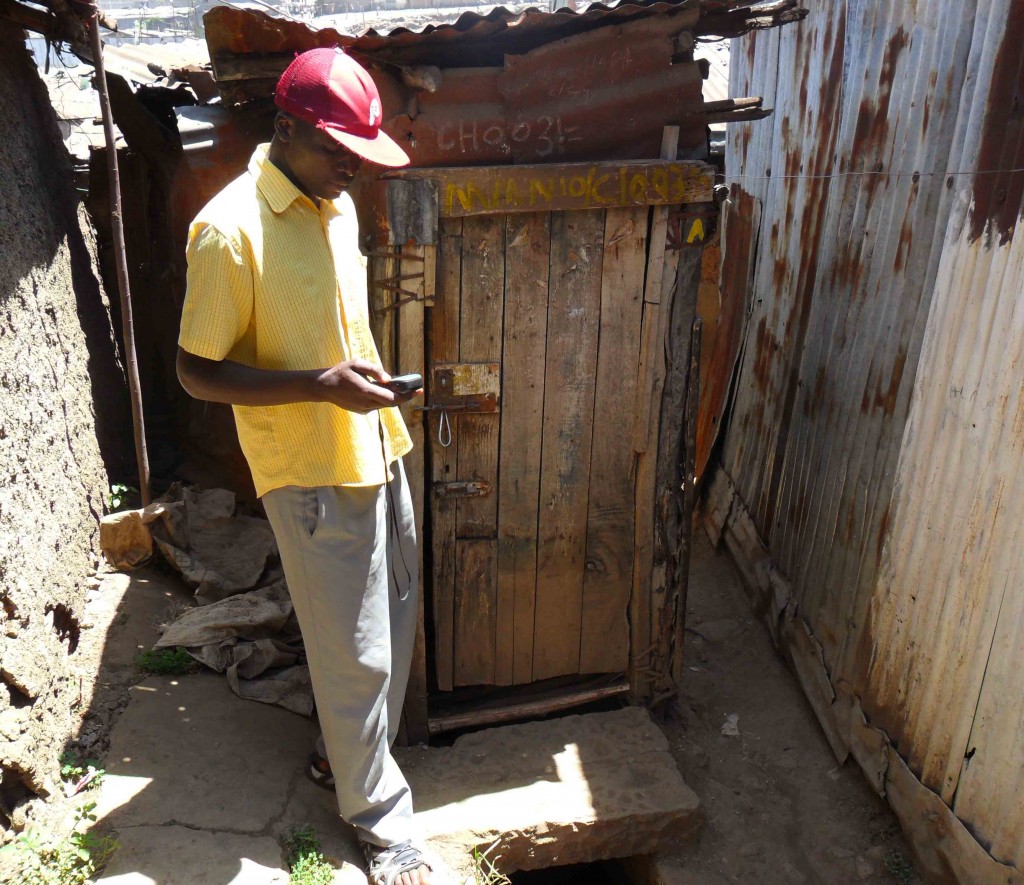
Jackson collecting a point in front of a toilet
The first phase of detailed water and sanitation data collection and editing is over. In two weeks our teams collected and edited 262 points including: 89 points with toilets, 108 water points and 65 open defecation areas.
What we learned from the numbers:
- The smaller number of toilets does not show the real picture as there can be many toilets at one point (we collected the number of units per point, but this is not reflected in the 89 figure).
- The number of open defecation areas is alarmingly high – there is almost the same number of toilet sites as there are open defecation areas – which clearly points to a lack of toilets.
- The number of toilets and water points will likely stay low because of the specific structure of Mathare: half of its buildings are high-rise apartment buildings that usually have toilets and water connections on every floor , which brings us to the next point:
- In order to get the real picture of the water and sanitation in Mathare, we need to figure out how to collect the data from these apartment buildings (it will need to be an inclusive approach, connecting community members, stakeholders, administration, government, etc.)
For the purpose of data editing we used basic mapping features to tag our points as amenities, like toilet and drinking water, and for ODAs we used the tag landuse-landfill. In addition to these basic features we added our own tagging scheme which we created so it coincided with the data collection forms.
There was some confusion here and there because of the massive amount of papers which contained the data of different points (something to think about in the future – how to get rid of the huge stocks of paper), but otherwise the data entry itself went well.
Here’s a detail from OSM showing all three features.
Phase two is already on under way.
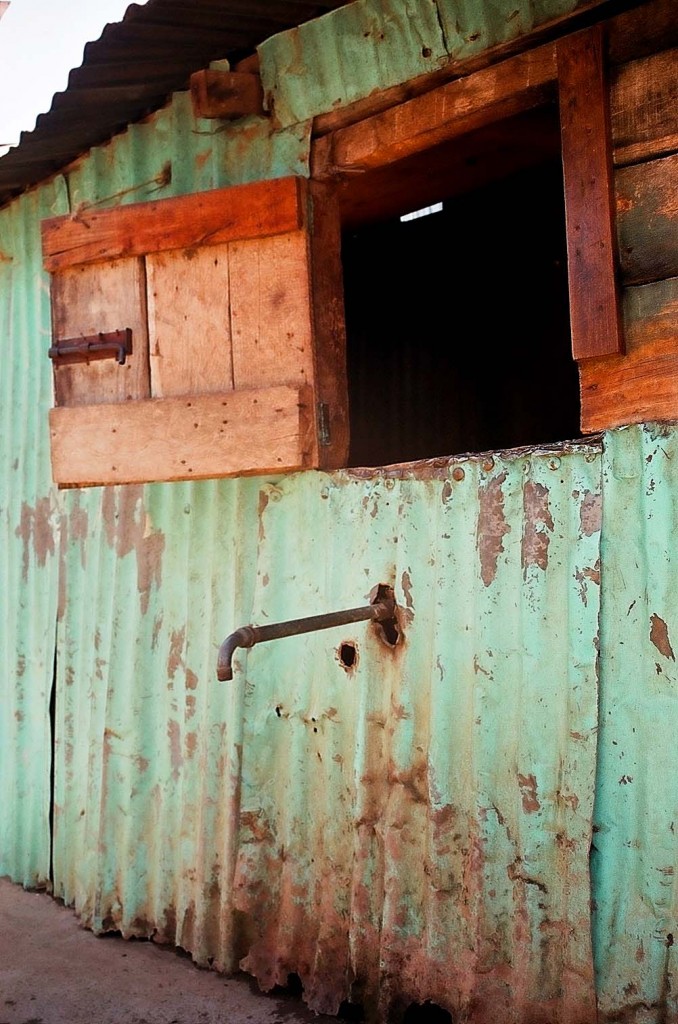
Water point










